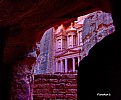Stuart,
Are you referring to colour or B&W? Colour materials, and dye-image B&W (XP-2 etc) will benefit from cold storage. Cooling will slow down the deterioration of the dyes. It doesn't matter so much with silver-image B&W. If you do use cold storage the containers need to be sealed before cooling, and not unsealed until after they have warmed back up. If you live in a very humid country you may need to take some measures to dry the film before cooling. Leave as little airspace in the container as possible.
Relative humidity is important. If you live in a humid climate, then it would be worth keeping your film in a drying cabinet to prevent mould growth.
Keep colour materials and dye-image B&W in the dark. The way dyes work makes them tend to self-destruct in the light.
The storage containers should be suitable for the archival storage of film. I use acid-free boxes to hold archival negative preserver sheets like Print File. Check out the B&H online catalog for options and an idication of prices. Way back, glassine was the standard material fot neg file pages but it fell out of favour because it was not as inert as some plastics materials like mylar - though it is better than PVC etc. I switched to mylar storage in the mid 70's. My glassine-stored negs have not shown any signs of degradation, however. Some of the plastic neg file pages are more prone to scratching the film than glassine, and that is a problem for me now.
Mt current preferred storage method is in the continuous sleeving often used by photo labs. Instead of being slid into a pocket from one end, it is just dropped in from the top - no scratching. Each film gets placed into an acid-free paper envelope, which is then stored in an acid-free box.
Best,
Helen
|
















